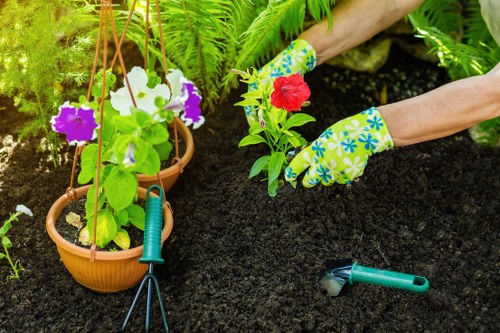Mastering Oven Cleaning: A Comprehensive House Cleaning Guide

Introduction to Oven Cleaning
Keeping your oven clean is essential for maintaining a healthy and efficient kitchen. Regular oven cleaning not only enhances the appliance's performance but also ensures that your meals taste better by eliminating burnt residues and unwanted odors.
Oven cleaning can seem like a daunting task, but with the right techniques and tools, it becomes manageable. This guide provides step-by-step instructions to help you achieve a spotless oven.
Understanding the importance of oven cleaning goes beyond aesthetics. A clean oven reduces the risk of fires, improves energy efficiency, and prolongs the lifespan of the appliance.

Why Regular Oven Cleaning Matters
Regular oven cleaning is crucial for several reasons. First, accumulated grease and food particles can lead to unpleasant smells and smoke during cooking, which can affect the taste and quality of your food.
Second, a dirty oven is less energy-efficient. When grime builds up on the heating elements and interior surfaces, the oven has to work harder to maintain the desired temperature, leading to higher energy bills.
Moreover, neglecting oven cleaning can shorten the appliance's lifespan. Corrosion and wear caused by buildup can damage the oven's internal components, resulting in costly repairs or the need for a replacement.

Essential Tools and Cleaning Agents
Tools You'll Need
- Protective Gloves: To protect your hands from harsh cleaning agents and hot surfaces.
- Scrubbing Pads: For removing stubborn grime and baked-on food.
- Microfiber Cloths: Ideal for wiping down surfaces without leaving streaks.
- Spray Bottles: Useful for applying cleaning solutions evenly.
- Plastic Scraper: Helps in lifting off dried residue without scratching the oven surfaces.
Effective Cleaning Agents
Choosing the right cleaning agents is vital for effective oven cleaning. Here are some options:
- Baking Soda and Vinegar: A natural and non-toxic combination that effectively breaks down grease and grime.
- Commercial Oven Cleaners: These are formulated to tackle tough stains but should be used with caution due to their chemical content.
- Lemon Juice: Provides a fresh scent and has natural cleaning properties.
- Dish Soap: Helps in cutting through grease and is generally safe for most oven surfaces.

Step-by-Step Oven Cleaning Process
Preparation
Before you begin cleaning, ensure that the oven is completely cool. Remove all racks, trays, and any other removable parts. Soak these components in warm, soapy water to loosen grime and make them easier to clean.
Next, lay down newspapers or old towels around the oven area to catch any spills or drips from the cleaning process. This will help in minimizing the cleanup required afterward.
Gather all your cleaning supplies and wear protective gloves to safeguard your hands from harsh chemicals and heat.
Cleaning the Interior
Start by making a paste using baking soda and water. Apply this paste generously to the oven's interior surfaces, avoiding the heating elements. Let it sit for at least 12 hours or overnight to allow the baking soda to break down the grease and grime.
After the paste has set, take a damp microfiber cloth and wipe away as much of the baking soda as possible. For stubborn spots, use a plastic scraper to gently lift the residue without scratching the oven surfaces.
Spray white vinegar over the remaining baking soda paste. The vinegar will react with the baking soda, creating a foaming action that helps in removing any lingering residue. Wipe the interior once more with a clean, damp cloth to finish the cleaning process.

Cleaning the Oven Racks
Soaking and Scrubbing
While your oven interior is drying, focus on the racks. After soaking them in soapy water, use a scrubbing pad to remove any remaining grime. For particularly tough stains, sprinkle some baking soda on the racks and scrub with a damp sponge.
If the racks have stubborn, baked-on residue, you can place them in a bathtub filled with hot water and a cup of dish soap or vinegar. Let them soak for several hours or overnight before scrubbing.
Rinsing and Drying
Once the racks are clean, rinse them thoroughly with warm water to remove any soap or cleaning agent residue. Dry them completely with a microfiber cloth before placing them back into the oven.

Cleaning the Oven Door
Glass Surface
The oven door glass can accumulate grease and fingerprints, which not only looks unattractive but can also interfere with accurate temperature readings. To clean the glass, use a mixture of equal parts water and vinegar in a spray bottle.
Spray the solution generously onto the glass surface and let it sit for a few minutes. Then, use a microfiber cloth or a soft sponge to wipe away the grime. For stubborn spots, a razor blade held at a 45-degree angle can be used carefully to scrape off the residue without scratching the glass.
Seal and Frame
Don't forget to clean the seals and frame around the oven door. Use a damp cloth with mild soapy water to wipe these areas, ensuring that no debris or spillage remains that could affect the oven's efficiency.

Exterior Cleaning
The exterior of your oven also requires regular maintenance to keep it looking pristine. Start by wiping down the surfaces with a damp microfiber cloth to remove dust and light grease.
For stainless steel ovens, use a stainless steel cleaner to achieve a streak-free shine. Apply the cleaner with a soft cloth, following the grain of the steel to avoid scratches.
For ovens with enamel or painted surfaces, use a mild detergent and a soft sponge to clean. Avoid using abrasive cleaners or pads that can damage the finish.

Maintenance Tips for a Clean Oven
Regular Wiping
After each use, allow the oven to cool down and then wipe away any spills or splatters. This prevents the buildup of grime and makes deep cleaning sessions less frequent and easier.
Use Oven Liners
Oven liners or mats can catch spills and drips, protecting the oven's interior from stains and reducing the need for extensive cleaning. Ensure that the liners are specifically designed for oven use and do not obstruct the heating elements.
Avoid Slamming the Oven Door
Closing the oven door gently minimizes the amount of debris that can accumulate on the door seals. This practice prolongs the life of the seals and maintains the oven's energy efficiency.

Natural and Eco-Friendly Cleaning Solutions
Baking Soda and Lemon
A combination of baking soda and lemon juice can create a powerful natural cleaner. Apply the mixture to the oven surfaces, let it sit for a few hours, and then wipe it away for a fresh and clean oven without harsh chemicals.
Vinegar Steam Cleaning
Using vinegar and water to create steam can help loosen grease and grime. Simply pour a mixture of equal parts vinegar and water into a heat-safe container, place it in the oven, and heat it to create steam. After cooling, wipe the interior clean.
Essential Oils
Adding a few drops of essential oils like tea tree or lemon to your cleaning solutions can enhance the cleaning power and leave a pleasant scent in your oven.

Common Oven Cleaning Mistakes to Avoid
- Using Harsh Scrubbers: Abrasive pads can scratch and damage the oven surfaces. Always opt for non-abrasive cleaning tools.
- Neglecting Regular Maintenance: Waiting until the oven is extremely dirty makes cleaning harder and less effective.
- Ignoring Manufacturer's Instructions: Always refer to the oven's manual for specific cleaning guidelines to avoid voiding warranties or damaging the appliance.
- Using Excessive Water: Too much water can seep into electrical components, causing damage. Use just enough to clean effectively.
- Rushing the Cleaning Process: Taking your time ensures a thorough and safe cleaning, preventing missed spots or accidents.
Conclusion
Maintaining a clean oven is a vital aspect of house cleaning that contributes to a healthier and more efficient kitchen environment. By following the steps outlined in this guide, you can ensure that your oven remains spotless and functions optimally.
Remember to incorporate regular maintenance practices, use the right cleaning agents, and avoid common mistakes to keep your oven in top condition.
For professional assistance or more specialized oven cleaning services, contact us today to ensure your kitchen stays immaculate and your appliances last longer.